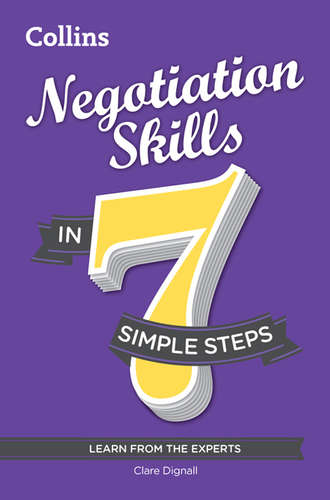
Полная версия
Negotiation Skills in 7 simple steps
2 Ensure they understand the issues, and each other: Before going into negotiations as a team, it’s imperative that your team know why you want to negotiate, that they understand how you came to this decision (and support it), and that they know each other really well. You don’t want an unpredictable member of your team suddenly asking you, in front of the opposite party, to clarify why negotiations are needed.
3 Have a proper discussion: Make time with your fledgling team to brainstorm the issues you want to air during negotiations, including the ‘what we want’ and ‘what we can give’ options. Agree both on what information you are willing to share with the opposing party, and what you must not mention in front of them.
Matching your team to negotiation roles
The next step in creating an effective team is to assign its members with discrete roles. Although specialisms are important, you’re not just looking for professional or technical skills, but personality traits too. Maybe you know someone who is unflappable in a crisis, or a people-person who makes others feel at ease. Experience is crucial too; a tough-nut negotiator who has been through this before is a great asset – if you know of one!
Your team may include as few as two of the following roles, or it may include all of them and more.
Lead negotiator: This spokesperson for the team makes the tough decisions and does most of the talking, as well as organizing and motivating the team.
A note-taker: Someone needs to impartially record the key agreements being made. There need only be one ‘scribe’ in a negotiation, so it’s good to agree early which party will provide one.
An observer: For big negotiations, there can be merit in having someone who can watch for signs of anxiety or resentment in the other party, and can share these insights in breaks or between meetings.
A numbers person: If you’re negotiating about buying, selling, or pay, for example, you may need someone who has a head for numbers, spreadsheets and forecasting.
An expert adviser: If you’re negotiating about one aspect in a specialist field, e.g. conservation, you may want someone who can bring expert insight to your strategy and who can answer complex questions with authority.
Know your authorities
Ensure that your people know that they can’t make proposals or counter offers over the lead negotiator, unless it’s been discussed in advance. Also, if the lead doesn’t have the power of ‘sign-off’, then you should make it clear from the outset that any agreements reached will have to be passed by the person who does have the authority. Being vague about this could irritate the other party and cause delay.
Decide how you’ll communicate
Consider whether to agree a set of discreet signals to communicate important things you may be unable to say out loud e.g.: ‘I disagree’; ‘stop talking’; ‘change the topic’; or ‘we need a break to talk’. Once you’ve got your signals, practise using them together until you can decipher them with confidence. If you need to say something specific, writing a note and pushing it under the eyes of a team member is acceptable too.

Key take-aways
Write down the things you will take away from Step 1 and how you will implement them.
Topic Take-away Implementation Understanding that negotiation is a part of everyday life I negotiate every day both at home and in the office. Bring some of the skills I use at home into the office environment. Understanding why we should negotiate Identifying negotiation skills already gained in everyday negotiating environments How to recognize when it’s a good time to negotiate How to prepare effectively for a negotiation How to identify what you want from negotiation How to identify what you can give to achieve results How to recognize your USP and use it effectively in negotiation How to recognize when a team might work well How to choose the right team How to assign roles to your teamStep 2
PREPARE YOUR STRATEGY
‘By failing to prepare, you are preparing to fail.’ — Benjamin Franklin, (1704–1790), Politician, Inventor and Scientist
Five ways to succeed
Create a flexible and researched negotiation strategy.
Be clear about what you want to gain.
Make an educated guess about the other party’s strategy.
Dress appropriately and comfortably.
Be positive and friendly when you arrive.
Five ways to fail
Allow your walk-away points to change during a negotiation.
Always assume you have the least leverage.
Don’t rehearse your strategy – be spontaneous.
Insist on negotiating at your chosen venue.
Speak very loudly to appear more confident.
Create your negotiation strategy
You’ve spent valuable time preparing for negotiations: gathering information and identifying what you want and what you can concede to reach a satisfactory agreement. Now it’s time to distil your efforts into a negotiation strategy: not a fixed plan, but a flexible guideline of what you hope to achieve and how you aim to act along the way.
Your strategy should consider the following, many of which you’ll have identified already from your preparation in Step 1:
What you want to have: These should include your ‘must-haves’ and a few ‘give-aways’ that you can offer if necessary.
What you must have: These are your minimum requirements. You need these for the negotiation to be successful.
Your BATNA: This is your Best Alternative To a Negotiated Agreement. If you simply can’t get what you want, your BATNA is your second-best option.
Your ‘walk-away’ point: This is the point where you have to stop negotiating, before you come away with less than your minimum requirements.
Your proposed approach: This is the manner in which you aim to reach a deal. In most cases, bargaining will be the mainstay of your negotiations, but you may find that haggling gets results for specific elements.
Make your strategy watertight
For your strategy to be in with a fighting chance it must be both realistic and informed. To knock it into shape, you can’t think about your negotiation strategy in isolation, but must understand the context in which you’ll use it.
Am I in the right ballpark?
To create a realistic negotiation proposal, find out as much as you can about the goal that you seek. Say, for example, you’re applying for a new job with prospects, but whose salary is just too low for you to start on, and you plan to negotiate it up if you get it. To create a workable strategy, first find out what your own ‘market value’ is, to avoid setting your sights too low or too high. You might check comparable positions on recruitment websites or in newspaper jobs pages, or speak to an adviser (at a job centre or a recruitment agency) for indicative salaries. Talk to (trusted) contacts who’ve negotiated pay to understand how their negotiated rise compared against what they’d hoped. If you’re representing a supplier company, the same applies; you must find out about your competitors’ prices before you set down your own in a negotiation strategy.
Who has the most leverage?
In negotiations ‘leverage’ is the term used to describe how much weight one party has in influencing how negotiations will turn out. Identifying how much leverage each party has will help you use your negotiation strategy effectively, and this discovery can be surprising. If you’re negotiating with a superior e.g. your boss, or a big corporate like your broadband provider, it’s easy to assume that they’ll have the most leverage, because they’re ‘higher up’ or ‘bigger’ than you, but this isn’t always the case.
Say you’ve interviewed for a new job and been offered it, though you still enjoy your present job. You could, at this point, meet with your current boss to negotiate better pay, and be the party with the most leverage. Why? You can go into negotiations knowing that you’ve nothing to lose and everything to gain. If your boss cannot meet your ‘must-have’ requirements, then you’re in the lucky position of your ‘walk-away’ scenario being exactly that – you can walk into another job. Pulling this information out of the bag when negotiations reach an impasse wields great leverage. Your boss knows that if he/she cannot meet at least your ‘must-have’ requirements he/she’s likely to lose you, and recruitment costs both time and money. Negotiate costs with a big broadband provider that loudly advertises affordability and you, as a paying customer, have some leverage because you’ve identified better deals, are willing to move elsewhere to get them, and are happy to tell your friends to do so too.
How do I stick to my walk-away points?
The safety-net that lies under your entire strategy is your ability to walk away at any point, before you’re drawn by momentum into agreeing on less than your ‘must-haves’. Your walk-away points needn’t be financially-driven. They can include anything that is unacceptable to you: signing a long contract when you need a shorter one; negotiations that last longer than a specified period; or having to move house if offered a promotion. Be careful to note all your walk-away points. There may be several, and they may be unrelated. They mustn’t be decided whilst you’re negotiating, but identified in advance, written down in a calm moment, and fixed in stone. They are non-negotiable. Give in on these and you risk everything, including your credibility: in plain terms, you’ve been walked over – publicly.
How does a BATNA work?
Not every negotiation can arrive at an agreement. Your Best Alternative To a Negotiated Agreement (BATNA) can provide an alternative to walking away and damaging relationships with those you have to work with afterwards. Say you’re negotiating with your manager for extra training, but she says ‘I simply have no budget for training’. Rather than walk away from the prospect of career progression, your BATNA may provide alternatives to satisfy some of your interests. Extra holiday entitlement, or half-day Fridays, would give you some capacity to pursue training under your own steam. The BATNA creatively acknowledges the fact that negotiations have failed to provide agreement now, but that you value the ongoing relationship.
Offer to draw up an agenda
Contact your opposite number, and ask what they’d like on the agenda for discussion. This will reveal the issues that are important to them, possible areas for mutual agreement, and will also highlight those questions that you’ve not yet considered in your research. Distributing this agenda will tell the opposite party what’s important to you, and oblige them to talk about it; they can’t wriggle out of an agenda point if they’ve agreed the document. An agenda saves time and minimizes surprises: no properly structured meeting should wander much from its original format. An advance agenda also removes the fear of the unknown, and gives you a chance to rehearse what you want to say.
Business writing: agendas
This simple but invaluable written document should include the date, time and venue, followed by a list of the people attending. Items for discussion are listed in the order you propose they be discussed, numbered accordingly. If anyone has a specific role, that’s worthwhile recording.
Date/Time: 01 February 2014 12:00 p.m. to 2:00 p.m.
Venue: Meeting Room C, Taylor Building
Attendees: Marc Fisher, Sarah Tait, Jim Morton
Items for discussion
1 Marc Fisher’s current roles and responsibilities
2 Office changes: next 12 months
3 Changes to office administration roles
4 Possible extra responsibilities for key staff
5 Training requirements
RESPONSIBILITIES
Record meeting decisions: Jim Morton
Make an educated guess about their strategy
By undertaking preparatory research about your opposite number, you may have an idea about what their negotiation strategy will be. An advance agenda will definitely clarify things further. But if, despite having done your homework, you still feel you don’t know what to expect, it’s still worthwhile making an educated guess, or guesses. Asking yourself the following questions will help you explore possible scenarios in your head. It may help you form an idea of the opposite party’s likely strategy and also whip your own into shape:
Are they likely to open with a proposal?
What might their proposals be?
What arguments do I have to counter them?
Do I think they will be ‘tough’ or accommodating?
How are they going to respond to my must-haves?
What counters will they have to my proposals?
Do I think they will give me a ‘take it or leave it’ ultimatum?
How will they rate the importance of my USP?
Asking yourself such simple, open questions will start you thinking creatively about how to respond to any number of scenarios. ‘Dealing with’ something in your head in advance of the meeting will make the real thing less surprising, and much less daunting.
Road test your strategy
If you’re feeling nervous about negotiating, be assured that you’re not alone. Like learning any difficult new skill, practice can both minimize anxiety and improve your performance.
Ask a friend to play a tough-nut negotiator over coffee one weekend, and try out your negotiation strategy against your educated guess at your opponent’s. Roleplay will not only help you practise speaking persuasively about your ‘must-haves’, but will sharpen your ability to think on your feet – vital in negotiations. Note those moments that you found particularly hard to get through: do you tend to lose your train of thought if someone interrupts you? Do you get upset if someone dismisses your argument? Identifying pressure points and finding ways to deal with them before you really have to is invaluable. Ask your friend for feedback – were your arguments compelling? Did you sell yourself? How confident was your body language? Their answers could be revealing.

Choose your venue
Just like in football, it’s usually preferable to negotiate on ‘home turf’, where you feel most secure. However, the importance of this can get over-emphasized, so don’t fret if you fail to persuade the other party to yours. Negotiating on their patch may not be your first choice but there are perks: because you’re an invited guest, you don’t need to deal with the details of providing hospitality, and can concentrate on the negotiations, and nothing else.
Meeting in a neutral location such as a hired meeting room or over coffee is just as good, potentially better. Not only are you both on an equal footing, but finding your feet somewhere new can offer opportunities for breaking the ice before you start: finding power points and water coolers becomes a group activity, gets both sides talking and helps you relax.
If talks are on home turf, avoid out-dated power games like sitting in an upholstered chair while the opposite party squirms on plastic ones. Try sitting round a table or side by side, rather than across it, to make both sides feel this is a shared problem rather than a head-to-head. Provide breaks, good refreshments, and make sure everyone knows where the restrooms are.
Your self-preparation
You’ve spent valuable time gathering information ahead of your negotiations, now it’s time to gather yourself too. Sparing a thought for your physical presentation is not a wasted effort; going into negotiation feeling good about yourself not only improves your own confidence; it will send out strong positive messages to those you are about to negotiate with too.
Dress
Конец ознакомительного фрагмента.
Текст предоставлен ООО «ЛитРес».
Прочитайте эту книгу целиком, купив полную легальную версию на ЛитРес.
Безопасно оплатить книгу можно банковской картой Visa, MasterCard, Maestro, со счета мобильного телефона, с платежного терминала, в салоне МТС или Связной, через PayPal, WebMoney, Яндекс.Деньги, QIWI Кошелек, бонусными картами или другим удобным Вам способом.





